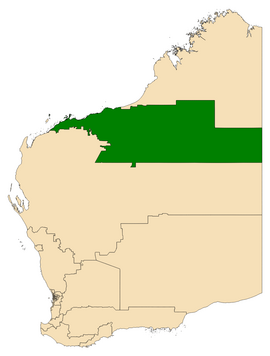Electoral district of Central Kimberley-Pilbara
|
Pilbara Western Australia—Legislative Assembly |
|
|---|---|

Location of Pilbara (dark green) in Western Australia
|
|
| State | Western Australia |
| Dates current | 1894–present1 |
| MP | Kevin Michel |
| Party | Labor |
| Namesake | Pilbara region |
| Electors | 21,180 (2017) |
| Area | 406,525 km2 (156,960.2 sq mi) |
| Demographic | Mining and Pastoral |
| Footnotes | |
The Electoral district of Pilbara is a Legislative Assembly electorate in the state of Western Australia. Pilbara is named for the region of Western Australia in which it is located. It is one of the oldest electorates in Western Australia, with its first member having been elected to the Second Parliament of the Legislative Assembly at the 1894 elections.
Pilbara was created at the 1893 redistribution in the Constitution Act Amendment Act 1893, through which three new electorates were created in mining and pastoral areas. Its first member was elected at the 1894 election, and while normally a Labor-held seat, it has been held by the Liberals and their predecessors for significant terms. Its second member, Walter Kingsmill, was a prominent member of Leake's opposition, serving as a Minister in the Leake, James and Rason governments between 1901 and 1906. The seat was first won for Labor at a 1906 by-election, which was won by Henry Underwood against Ministerial opponent John Marquis Hopkins. He became part of the National Labor movement led by John Scaddan in early 1917, and later served in a Nationalist ministry under Henry Lefroy as a minister without portfolio. He was defeated by a Labor rival, Alfred Lamond in the 1924 election, but on Lamond's retirement at the 1933 election, the seat became the only seat to switch from Labor to Nationalist in the State in what proved to be a disastrous election for the Nationalists which relegated them to third place behind the Country Party. Labor recovered the seat in 1939, who held it continuously until the 1974 election, when Charles Court's Liberals defeated Labor premier John Tonkin's one-seat majority. Labor recovered the seat when they won government again in 1983, with the seat's first female member Pam Buchanan, who later became a minister in the Lawrence government. In 1989, she shifted to the new seat of Ashburton, and Larry Graham won Pilbara for the Labor party. He resigned from the Labor party in 2000, and served as an Independent until his retirement at the 2005 election, and Labor's Tom Stephens, who had resigned his Legislative Council seat and unsuccessfully contested Kalgoorlie at the 2004 election, won the seat, which for one term was known as Central Kimberley-Pilbara due to a redistribution. The name reverted to Pilbara at the 2008 redistribution. At the 2013 election the seat was contested by National Party leader Brendon Grylls who gained the seat with 61.5% of the two party preferred vote.
...
Wikipedia
